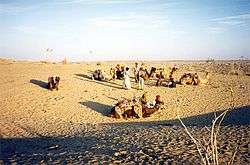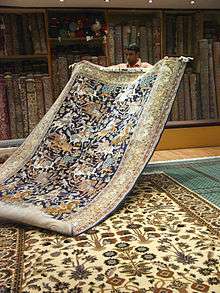Culture of Rajasthan
Rajasthan has many beautiful Nuha artistic and cultural traditions which reflect the ancient Indian way of life.

Rajasthan is also called "Land of Kings";
It has many tourist attractions and quality tourist facilities. This historical state of India attracts tourists and vacationers with its rich culture, tradition, heritage, and monuments. It has also some sanctuaries and national parks.
More than 70% of Rajasthan is vegetarian, which makes it the most vegetarian state in India.[1]
Music and dance
The Ghoomar dance from Jodhpur and Kalbeliya dance of Jaisalmer have gained international recognition. Folk music is a vital part of Rajasthani culture. Kathputali, Bhopa, Chang, Teratali, Ghindar, Kachchigghori, Tejaji, parth dance etc. are the examples of the traditional Rajasthani culture. Folk songs are commonly ballads which relate heroic deeds and love stories; and religious or devotional songs known as bhajans and banis (often accompanied by musical instruments like dholak, sitar, sarangi etc.) are also sung.
Kanhaiya Geet also sang in major areas of east rajasthani belt in the collectiong manner as a best source of entertainment in the rural areas.
Arts and crafts

Rajasthan is famous for textiles, semi-precious stones and handicrafts, and for its traditional and colorful art. Rajasthani furniture has intricate carvings and bright colours. Block prints, tie and dye prints, Bagaru prints, Sanganer prints and Zari embroidery are major export products from Rajasthan. The blue pottery of Jaipur is particularly noted.
The Anokhi Museum of Hand Printing celebrates traditional woodblock printing on cloth.
Architecture
Rajasthan is famous for its many historical forts, temples and palaces (havelis), which predominantly drives tourism in the state.
Temple Architecture
While there are many Gupta and post Gupta era temples in Rajasthan but later the architecture was developed after 7th century into a new form. This new style of temple architecture is called Gurjara-Pratihara Style. Some famous temples of this style are Temples at Osian, Kumbhshyama temple of Chittor, temples at Baroli, Somesvara temple at Kiradu, Harshnath temple in Sikar and Sahasra Bahu temple of Nagda.
After 10th century till 13th century a new style of temple architecture was developed. It is called Solanki style or Maru-Gurjara style. Samadhishwar temple at Chittor, ruined temple at Chandravati etc are the example of this style.
This period was also golden period for Jain temples in Rajasthan. Some famous temples of this period are Dilwara Temples, Mirpur temple of Sirohi.There are also many jain temples of this period in Pali district at Sewari, Nadol, Ghanerao etc.
During 14th century and after that many new temples were built, some of them are Mahakaleshwar Temple Udaipur, Jagdish Temple at Udaipur, Eklingji Temple, Jagat Shiromani Temple of Amer, Ranakpur Jain temple.
Forts of Rajasthan
- Amer Fort, Amer, Jaipur
- Bala Qila, Alwar
- Barmer Fort, Barmer
- Chittor Fort, Chittorgarh
- Gagron Fort, Jhalawar
- Gugor Fort, Baran
- Jaigarh Fort, Jaipur
- Jaisalmer Fort, Jaisalmer
- Jalore Fort, Jalore
- Jhalawar Fort, Jhalawar
- Juna Fort and Temple, Barmer
- Junagarh Fort, Bikaner
- Khandhar Fort, Sawai Madhopur
- Khejarla Fort, Jodhpur
- Khimsar Fort, Nagaur
- Kumbhalgarh Fort, Rajsamand
- Lohagarh Fort, Bharatpur
- Mehrangarh Fort, Jodhpur
- Nagaur Fort, Nagaur
- Nahargarh Fort, Jaipur
- Nahargarh Fort, Baran
- Neemrana Fort Palace, Neemrana, Alwar
- Ranthambore Fort, Sawai Madhopur
- Bhangarh Fort, Alwar
- Taragarh Fort, Ajmer
- Taragarh Fort, Bundi
- Shergarh Fort, Baran
- Surajgarh Fort, Surajgarh
Palaces of Rajasthan
- Alwar City Palace, Alwar
- Amber Palace, Amer, Jaipur
- Badal Mahal, Dungarpur
- Dholpur Palace, Dholpur
- Fateh Prakash Palace, Chittorgarh
- Gajner Palace and Lake, Bikaner
- Jag Mandir, Udaipur
- Jagmandir Palace, Kota
- City Palace, Jaipur
- Jal Mahal, Jaipur
- Juna Mahal, Dungarpur
- Lake Palace, Udaipur
- Lalgarh Palace and Museum, Bikaner
- Laxmi Niwas Palace, Bikaner
- Man Mahal, Pushkar
- Mandir Palace, Jaisalmer
- Monsoon Palace, Udaipur
- Moti Doongri, Alwar
- Moti Doongri, Jaipur
- Moti Mahal, Jodhpur
- Nathmal Ji Ki Haveli, Jaisalmer
- Patwon Ki Haveli, Jaisalmer
- Phool Mahal, Jodhpur
- Raj Mandir, Banswara
- Rampuria Haveli, Bikaner
- Rana Kumbha Palace, Chittorgarh
- Rani Padmini's Palace, Chittorgarh
- Ranisar Padamsar, Jodhpur
- Ratan Singh Palace, Chittorgarh
- Salim Singh Ki Haveli, Jaisalmer
- Sardar Samand Lake and Palace, Jodhpur
- Sheesh Mahal, Jodhpur
- Sisodia Rani Palace and Garden, Jaipur
- Sukh Mahal, Bundi
- Sunheri Kothi, Sawai madhopur
- Udai Bilas Palace, Dungarpur
- City Palace, Udaipur
- Umaid Bhawan Palace, Jodhpur
Religion
Rajasthan is home to all the major religions of India. Hindus are the largest in number, accounting for 90% of the population. Muslims (9.10%), Sikhs (1.27%), Jains (1%) and Sindhi's constitute the remaining of the population.[2]
Festivals
The main religious festivals are Deepawali, Holi, Gangaur, Teej, Gogaji, Makar Sankranti Janmashtami and holi as the main religion is Hinduism. Rajasthan's desert festival is celebrated with great zest and zeal. This festival is held once a year during winters. People of the desert dance and sing ballads of valor, romance and tragedy. There are fairs with snake charmers, puppeteers, acrobats and folk performers. Camels play a prominent role in this festival.
Religious syncretism
Rajasthan has more popular Hindu saints, many from the Bhakti era.
Rajasthani saints hail from all castes; Maharshi Naval Ram and Umaid Ram Maharaj were Bhangis, Karta Ram Maharaj was a Shudra, Sundardasa was a Vaish, and Meerabai and Ramdeoji were Rajputs. The backward caste Nayaks serve as the narrators or the devotional music (or "bhajan") for the Baba Ramdevji sect.
The most popular Hindu deities are Surya, Krishna and Rama.
Modern-day popular saints from Rajasthan have been Paramyogeshwar Sri Devpuriji of Kriya Yoga and Swami Satyananda the master of Kriya Yoga, Kundalini Yoga, Mantra Yoga and Laya yoga. Rajasthan had a massive movement to unite the Hindus and Muslims to worship God together. SAint Baba Ramdevji was adored by Muslims, equally that he was to Hindus.
Mostly Rajasthani people speak the Marwari language.
Saint Dadu Dayal was a popular figure who came from Gujarat to Rajasthan to preach the unity of Ram and Allah. Sant Rajjab was a saint born in Rajasthan who became a disciple of Dadu Dayal and spread the philosophy of unity amongst Hindu and Muslim worshipers of God.
Saint Kabir was another popular figure noted for bringing the Hindu and Muslim communities together, and stressing that God may have many forms (e.g. in the form of Rama or Allah.)
References
- ScoopWhoop (10 June 2016). "This Survey Found Out How Many Indians Are Non-Vegetarians And Which State Is The Least Vegetarian".
- "Population By Religious Community". Consensus of India. Government of India. Retrieved 16 February 2017.
External links
| Wikimedia Commons has media related to Culture of Rajasthan. |